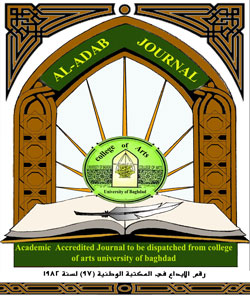The effect of synoptic patterns on pressure level (500 Hectobascal) on the occurrence of heavy rains in Sulaymaniyah province
DOI:
https://doi.org/10.31973/aj.v0i134.813Keywords:
synoptic patterns, heavy rains, Sulaymaniyah GovernorateAbstract
Heavy rain refers to the large number of rains in a specific period of time, and because of the different geographical characteristics, the determination of the ingredients and quantities of these rains varies from one region to another. Because of the topography and the geographical location of the Sulaymaniyah Governorate, which is located in the semi-tropical regions, therefore heavy rain falls, including heavy rains, therefore the presence of rugged mountains in this province has a great importance in reserving air humidity and thus heavy rains fall. In this paper, the classification of synoptic patterns of heavy rains in Sulaymaniyah Governorate and the climatic characteristics of this phenomenon have been highlighted according to location and time.
The research indicates that the occurrence of heavy rains occurs in mountainous regions more than the plain areas, and for the time of the occurrence of the phenomenon there was a difference in the frequency of heavy rains according to the seasons for all stations in the winter (61.4%) and (20.5%) in the spring and ( 17.9%) in the fall semester. In addition, at the level of months, months came (February, December, January), as the most frequent numbers of heavy rains were recorded. As for the classification of synoptic patterns, and after determining (97) joint days for heavy rains in the Sulaymaniyah governorate and their representation with synoptic maps, the maps were distributed to (7) different groups. The most frequent group (D) was (45) members, meaning the eastern Mediterranean dawn.
Downloads
References
Al-Dzaiy, Salar Ali Khidher, 2014, Concepts and theories of Synoptic climatology, First Edition, Al-Raya Publishing, Amman, Jordan.
Alijani, Behloul,1392, Synoptic climatology, Fifth Edition, Samat Publications, Tehran.
Alijani,B. 2002. ‘Variation of 500 hpa flow patterns over Iran and surrounding areas and their relationship with the climate of Iran’. Theor. Appl. Climatol. 72, 41-54.
ecmwf reanalyze, Daily mean, 2003-2018.
General Directorate of Weather and Earthquake Survey, 2019.
Ghasem, Azizi, 1385, Synoptic analysis of heavy rain in west of Iran, Journal of Natural Geography, First Year, No.
https://www.esrl.noaa.gov/psd/data/gridded/data.ncep.reanalysis.pressure.html
Manuchehr, Farajzadeh,1391, Iranian Climate Hazards, First Edition, Samt Publications, Tehran.
Mohammadi Bakhtiar, Masoodian, Abolfazl ,(2010), Journal of Geography and Development, No. (9), pp. 47-70.
noaa composite data,DAILY MEAN, NOAA/ESRL PHYSICAL SCIENCE DIVISION, NCEP/NCAR REANALYSIS, 2.5*2.5, 2003-2018.
Riza Doostan and Mirdrikund, Mohammad, (2013), Synoptic analysis of heavy and pervasive rains in western Iran, International Conference on Environmental Hazards, 7 and 8 October.
S V Kostarev, B A Sivkov, A L Vetrov, V E Tiunov and A V Bykov, Synoptic typification of heavy rain events in Perm region, Earth and Environmental Science 211 (2018) 012060, 1-6.
Stull, R.B. 2000. ‘Meteorology for scientists and engineers. Second edition, Brooks/Cole. USA.
Taha,Ahmed,1394, Statistical-synoptic analysis of pervasive drought and wet patterns in Iraqi Kurdistan ,M.Sc. Thesis, Natural Geography, Synoptic Climate Tendency, University of Tehran.
Yarnal, B. 1993. Synoptic climatology in environmental analysis. Belhaven Press, London and Florida.
Yarnal, Brent,(1373), Synoptic Climatology in Environmental Analysis,Translated by Seyed Abolfazl Masoodian, University of Isfahan.
Downloads
Published
Issue
Section
License
Copyright and Licensing:
For all articles published in Al-Adab journal, copyright is retained by the authors. Articles are licensed under an open access Creative Commons CC BY 4.0 license, meaning that anyone may download and read the paper for free. In addition, the article may be reused and quoted provided that the original published version is cited. These conditions allow for maximum use and exposure of the work.
Reproducing Published Material from other Publishers: It is absolutely essential that authors obtain permission to reproduce any published material (figures, schemes, tables or any extract of a text) which does not fall into the public domain, or for which they do not hold the copyright. Permission should be requested by the authors from the copyrightholder (usually the Publisher, please refer to the imprint of the individual publications to identify the copyrightholder).
Permission is required for: Your own works published by other Publishers and for which you did not retain copyright.
Substantial extracts from anyones' works or a series of works.
Use of Tables, Graphs, Charts, Schemes and Artworks if they are unaltered or slightly modified.
Photographs for which you do not hold copyright.
Permission is not required for: Reconstruction of your own table with data already published elsewhere. Please notice that in this case you must cite the source of the data in the form of either "Data from..." or "Adapted from...".
Reasonably short quotes are considered fair use and therefore do not require permission.
Graphs, Charts, Schemes and Artworks that are completely redrawn by the authors and significantly changed beyond recognition do not require permission.
Obtaining Permission
In order to avoid unnecessary delays in the publication process, you should start obtaining permissions as early as possible. If in any doubt about the copyright, apply for permission. Al-Adab Journal cannot publish material from other publications without permission.
The copyright holder may give you instructions on the form of acknowledgement to be followed; otherwise follow the style: "Reproduced with permission from [author], [book/journal title]; published by [publisher], [year].' at the end of the caption of the Table, Figure or Scheme.











